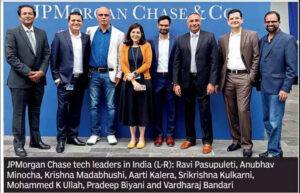SEPTEMBER 21, 2023

When depositors rushed out of Silicon Valley Bank earlier this year, they headed to bigger banks with their money. JPMorgan Chase, the largest bank in the US, as also the world, was among the major beneficiaries. Thousands wanted to suddenly open accounts with the bank. Traditional banks would find that tough to handle.
But the transformational technology initiatives JPMorgan Chase has taken in the past few years, including the big move into private and public cloud, made it easy for the bank to handle this surge in demand. And India, where the bank has 19,000 of its 57,000 tech employees, played a central role in this.
More than 60% of the technology and business teams that handle client onboarding sit out of the bank’s centres in Mumbai, Bengaluru and Hyderabad. “So, overnight, we were able to handle that unforeseen excess volume in client onboarding. The SME (subject matter expert) knowledge was here, the tech was here, and given the way we had built our systems on modern technical stack, including AI/ML capabilities, we were able to build some of the additional services to scale that onboarding very quickly,” Mohammed K Ullah, MD & head of global technology enterprise infrastructure services for India and Apac at JPMorgan Chase, says.
Work like this has made India an epicentre for the bank in building out cutting-edge business-enabling capabilities. While India has extensive and quality technology talent, which is the primary reason why many global companies come here to establish what are called global capability centres (GCCs), one of the big advantages JPMorgan Chase has in the country is also a large presence of highly experienced operational talent for every division of the firm – investment banking, financial services for consumers and small business, commercial banking, financial transactions processing, and asset management. The bank’s GCC in India is one of the biggest in the country, with over 50,000 employees. That allows the technology and operational talent to work together easily to find solutions to problems the business functions face. In Bengaluru and Mumbai, the bank recently moved into large new campuses, partly with the objective of bringing operational and tech talent closer together. So that they can “ideate seamlessly.”
Last year, the bank announced a $14 billion budget for tech, with $6 billion of that to go into new digital products and services to support growth and run daily operations, and $4 billion into infra structure modernisation and building firm-wide platforms that can provide scale.
A lot of this has been coming into India. Engineers here have used technology in wealth management, for instance, to reimagine and automate the entire business lifecycle – from client prospecting to client conversion, and portfolio management. “We are automating using AI capabilities, including generative AI,” Ullah says.
Engineers here have helped develop fraud detection techniques using AI. They have played a central role in the bank’s move initially to private cloud, and now increasingly to public cloud – which in turn is enabling solutions around data management and insights. In the payments space, they are reimagining the flows to make them more efficient, seamless and error free. In engineering, they are looking to automate tests and validations, as well as production error management.
Digital Assistant is a product for internal usage, built entirely out of India, and which is seen to have created huge efficiencies for the organisation globally. Prashant Mekaraj, senior director of engineering, conceptualised and led the project. The problem he had to solve was that JPMorgan Chase, being so large, diverse and geographically widespread, used a variety of tools, many of which did not talk to each other. For video calls, for document sharing, for a range of other tasks, different groups used different tools. Mekaraj and team’s accomplishment was to connect many of these tools, and create a single interface – a small bar that sits on the desktop – that can be used by any of the bank’s over 2.4 lakh employees to collaborate, share, and look up a variety of information. “Interactions that would take 45 seconds to a minute to activate, we cut it down to 5-10 seconds,” he says.
Courtesy/Source: TOI / PTI










































































































